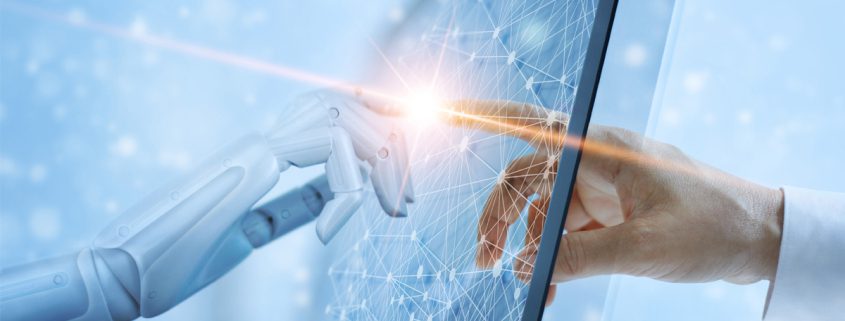Artificial Intelligence: Useful Tool or Something to Fear
Depending on who you’re listening to, artificial intelligence (AI) can either conjure up a HAL 9000 or a benevolent WALL-E scenario. In any event, the genie has been released from the bottle and there’s no turning back. It’s understandable that some folks are wary of this technology. Probably the best way to address your issues and questions about AI is to arm yourself with the facts and then proceed with caution while staying open to the possibilities of what this technology can bring. One thing is for sure, all of us are already using AI in one capacity or another.
So, let’s start with the basics.
According to Oxford Languages, artificial intelligence is “the theory and development of computer systems able to perform tasks that normally require human intelligence, such as visual perception, speech recognition, decision-making, and translation between languages.” AI systems have three parts: data, algorithms, and processing power. Data refers to the information used by the system to make decisions or solve problems. Algorithms refers to the set of instructions to be followed in calculations or other operations. Processing power refers to how fast the computer can execute these instructions. Simply put, AI systems complete tasks, make decisions, and make problem-solving easier.
There are three stages of AI: Artificial Narrow Intelligence, Artificial General Intelligence, and Artificial Super Intelligence. Artificial Narrow Intelligence (ANI) is programming that performs a single specific task, pulling data from predefined data sets and rendering real time results. Many times, performing one task immediately following another. ANI is what we currently are interacting with daily. Artificial General Intelligence (AGI) is where machines can perform any intellectual task that a human can, making decisions based on knowledge, perceptions, and feelings. There currently aren’t any AGI systems in existence today. Mother from the movie Her is an example of AGI. Lastly, Artificial Super Intelligence (ASI) is where machines will be capable of intellect far superior to any human, have their own consciousness and become self-aware. Many people fear that when ASI is real, computers will take over the world.
Artificial Intelligence in Use
Artificial intelligence has been incorporated into almost every aspect of our lives. AI runs on our cell phones and computers with voice assistants like Siri and Cortana, voice recognition, facial recognition, and photo editing. AI runs in our homes on our smart appliances – like the refrigerator that can read us recipes and send our grocery list to our smartphone – and Alexa who answers questions, sets reminders, plays music at our request, and more.
AI has also been embedded into most web browsers and websites. We are using AI when we do a Google search, see recommended products on Amazon, and when we chat on a website with customer service representatives (those are Chatbots not real people). Social media sites use artificial intelligence to show us items in our news feeds and ads believed to be relevant to us. Dating apps use artificial intelligence to match us with the ideal date or perfect life partner.
Companies use artificial intelligence in a variety of ways as well. Manufacturing plants have assembly-line robots. The medical field uses AI for scheduling, administration services, assisting with diagnosis, and robotic surgeries. Law enforcement, fire departments, financial service companies, commercial real estate firms and almost every other industry use artificial intelligence in one way or another.
Advantages of Artificial Intelligence
As AI handles tasks at a pace and scale that humans can’t match, efficiency, productivity, and cost savings top the lists of benefits. The average person prospers from tailored access to products, services and news feeds to machines that do their chores for them making their daily life more comfortable. Companies save money by allocating mundane tasks to AI while freeing up their employees to use their knowledge and talents on projects that technology currently can’t accomplish alone.
Chatbots and customer service AI integrations can quickly answer customer questions, schedule appointments, and direct customers to products and resources resulting in companies interacting with more customers and increasing customer satisfaction. Programs and sites like ChatGPT assist with writing articles, emails and social media posts by pulling information from online resources and formatting with correct grammar and punctuation. There are even AI services for graphic design, website development, and plugins for excel and financial modeling that can improve our work product.
Artificial intelligence also improves our health and safety. AI provides safe and effective ways to deal with dangerous scenarios such as the interaction with radiation, toxic waste materials and bombs. AI provides better predictive technology and efficiency to many industries, taking some of the guesswork out of equipment failure, repairs, and downtime. AI can lead to less workplace accidents from equipment malfunction.
Disadvantages of Artificial Intelligence
Stephen Hawking once stated, “The development of artificial intelligence could spell the end of the human race.” Aside from the end of the world scenario, the disadvantages range from costly implementation, potential human job loss, to the lack of emotion and creativity.
Although many AI services are free to use or available for a low subscription rate, many large companies spend millions of dollars to develop and implement customized programs tailored for their industry. But as more advanced AI services are made available, fewer workers are necessary to perform these tasks. Call centers, manufacturers and even IT and technical support companies are reducing their work forces due to AI implementations.
Thought leadership and originality may be going by the wayside. AI tools used to generate writing can only pull data from existing sources and data sets. It’s just a regurgitation of facts written by others that is being passed off as original work. American venture capitalist Paul Graham dubbed this AIgiarism. Graham said, “The problem with plagiarism [and algiarism] is not just that you’re taking credit away from someone else but that you’re falsely claiming it for yourself.” Academics are being inundated with nonoriginal or plagiarized works resulting in AI detectors being created to identify AI writing. AI detectors like Turnitin, Grammarly, GPTZero are being implemented by high schools, colleges, and universities, so students should be cautious of using AI writing tools. The music industry, journalism, screen and television writers are also being flooded by AI created works.
Warnings to Consider
The Center for AI Safety (CAIS) published this succinct statement “Mitigating the risk of extinction from AI should be a global priority alongside other societal-scale risks such as pandemics and nuclear war.” The list of signatories on the statement is quite impressive including executives from the top four AI firms: OpenAI, Google DeepMind, Microsoft and Anthropic. As CAIS explained, the statement was a way to encourage AI experts, journalists, policymakers, and the public to overcome the difficult-to-voice concerns obstacle and open discussions of advanced AI’s most severe risks.
As AI continues to transform every industry, including Commercial Real Estate, it’s imperative for users to keep their fingers on the pulse of this fast and ever-changing technology. Although the consensus is not unanimous on the repercussions of AI in our lives, human interaction remains the glue that a robot or computer cannot replace… at least for now.









